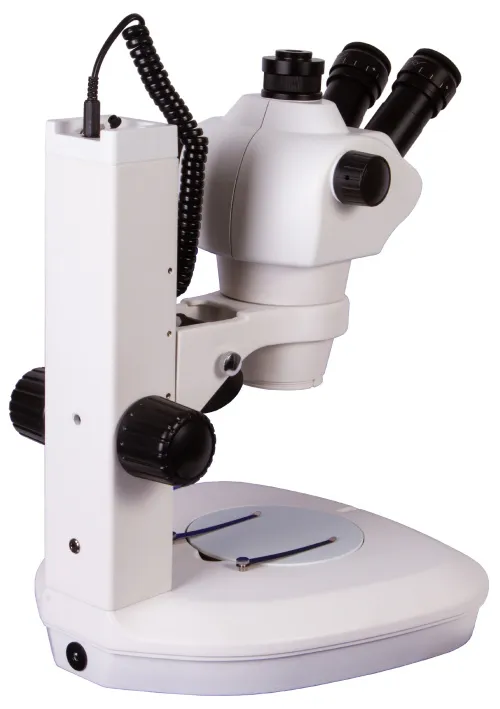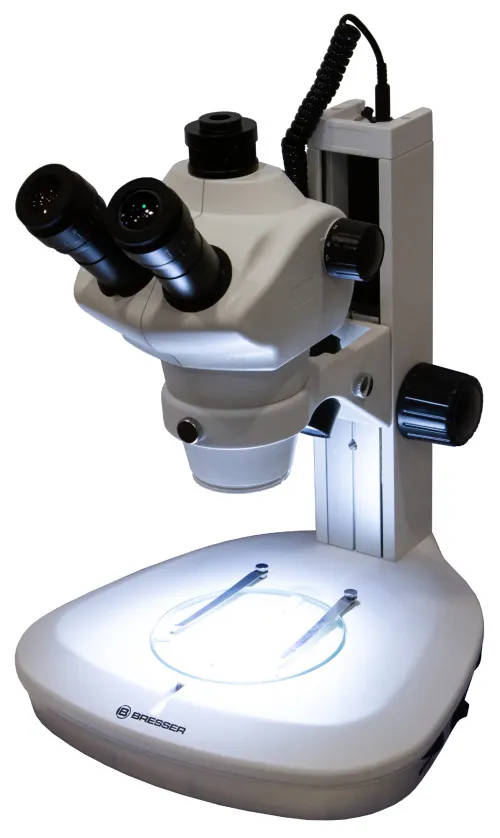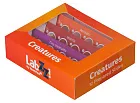Bresser Science ETD-201 8x-50x Trino Zoom Stereo Microscope
Trinocular head. Magnification: 8x–50x
| Product ID | 74317 |
| Brand | Bresser GmbH, Germany |
| Warranty | 2 years |
| EAN | 4007922030807 |
| Package size (LxWxH) | 36x36x41 cm |
| Shipping Weight | 6.82 kg |
The Bresser Science ETD-201 is a high-quality stereo reflected-light and transmitted-light microscope. It is perfectly qualified for medical applications, the use in agriculture and forestry, in criminology, in academic and scientific institutes and schools, as well as for the assembly and quality assurance of components in precision mechanics and electronic engineering.
The extra wide foot with stage and exceptionally tall height range permit observations of large objects. The integrated reflected- and transmitted-light illumination can be used in combination and is dimmable. The angle of incidence can be user-friendly adjusted and locked in position. A continuous range of magnification from 8x to 50x is possible with the exchangeable wide field eyepieces (WF10x) and the 6.25-times stereo zoom objective lens (0.8x–5x).
The interpupillary distance and dioptre compensation can be adjusted individually. The trinocular microscope head is rotatable (360°) and comes with two 45° inclined eyepiece tubes and a separate camera tube for the attachment of a c-mount camera or MikroCam.
Very versatile power supply system via USB port and cable or mains adapter (both included).
Features:
- Microscope for incident-light microscopy
- Object stage with two-colour object plate and glass plate
- LED illumination with stepless brightness adjustment
- Exchangeable eyepieces
- Universal USB power adapter with two adapter attachments
The kit includes:
- Microscope zoom head
- Microscope stand
- 2x eyepiece (WF10x)
- USB mains adapter (Euro and UK) and cable
- Glass plate
- Plastic plate (black&white)
- Dust cover
- Manual
| Product ID | 74317 |
| Brand | Bresser GmbH, Germany |
| Warranty | 2 years |
| EAN | 4007922030807 |
| Package size (LxWxH) | 36x36x41 cm |
| Shipping Weight | 6.82 kg |
| Type | stereo/instrumental |
| Microscope head type | trinocular |
| Head | 360 ° rotatable |
| Head inclination angle | 45 ° |
| Magnification, x | 8 — 50 |
| Eyepiece tube diameter, mm | 30 |
| Eyepieces | WF10x |
| Objectives | 0.8–5x (zoom) |
| Working distance, mm | 55 — 75 |
| Eyepiece diopter adjustment, diopters | ±1 |
| Illumination | LED |
| Brightness adjustment | ✓ |
| Power supply | output: 5V |
| User level | experienced users, professionals |
| Application | school/educational, laboratory/medical |
| Illumination location | dual |
| Research method | bright field |
| Pouch/case/bag in set | case |
We have gathered answers to the most frequently asked questions to help you sort things out
Find out why studying eyes under a microscope is entertaining; how insects’ and arachnids’ eyes differ and what the best way is to observe such an interesting specimen
Read this review to learn how to observe human hair, what different hair looks like under a microscope and what magnification is required for observations
Learn what a numerical aperture is and how to choose a suitable objective lens for your microscope here
Learn what a spider looks like under microscope, when the best time is to take photos of it, how to study it properly at magnification and more interesting facts about observing insects and arachnids
This review for beginner explorers of the micro world introduces you to the optical, illuminating and mechanical parts of a microscope and their functions
Short article about Paramecium caudatum - a microorganism that is interesting to observe through any microscope
















